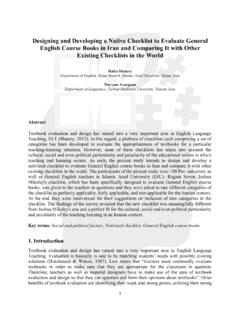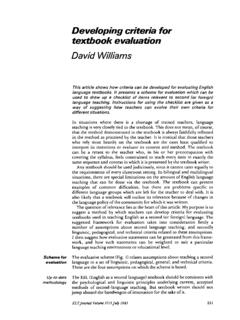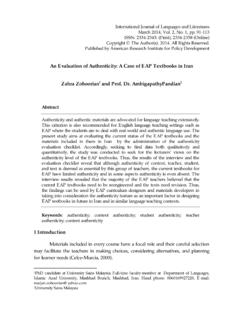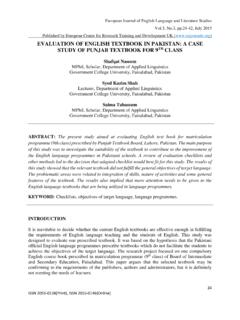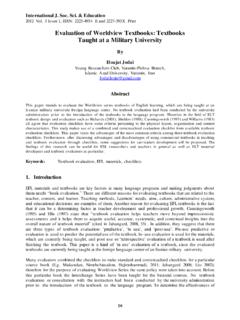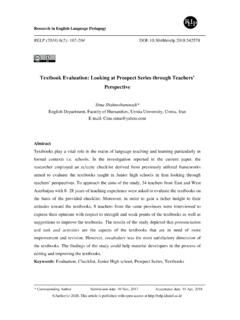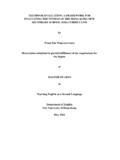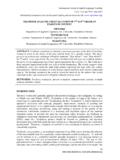Transcription of How to Evaluate an EFL/ESL Textbook- a Problem and a …
1 ASA University Review, Vol. 7 No. 1, January June, 2013 How to Evaluate an EFL/ESL textbook - a Problem and a Solution Ishrat Zahan* Jahanara Begum** Abstract English is treated almost as a second language in Bangladesh. Teaching and learning English, for this reason, is very important in our country not only in primary, secondary or higher secondary level but also in tertiary and upper tertiary level. For teaching English in a developing country like ours which lacks the sufficient number of skilled teacher, textbook is essential Textbooks make classes very much effective and focused for the students as well as for the teachers. But to have the desired goal, choosing an appropriate textbook for a language class is essential. How to choose a correct textbook for an ESL/EFL(English as Second Language/ English as foreign Language) class can be a burning question for the teacher.
2 Here in this article we tried to find out an easy but effective way of evaluating the merit of a textbook by using certain criteria with a rating system and thus help the teachers to choose the appropriate textbook for their need. Key Words: ESL/EFL textbook , effective teaching and learning, evaluation , criteria, rating system, instructional materials. How necessary is a textbook for an ESL/EFL classroom in Bangladesh? The answer to this question will definitely be a positive one by most of the language teacher of the country. Since in a developing country like ours where learning materials other than the textbooks are difficult to find and so to use, textbooks provide ready made and cheap teaching text, learning tasks and learning materials. In many situations textbook serves as a syllabus and guides the teachers and students in their way of teaching and learning.
3 In Brumfit s words textbooks are masses of rubbish skillfully marketed (Brumfit, 1980, ). But in an ESL/EFL classroom using textbook can facilitate both the teachers and the students with a more effective and organized teaching and learning process. Teachers depend much on textbooks in making the class room effective. So choosing an appropriate textbook is important. The quality and quantity of textbook have increased dramatically over the recent years making the choice of appropriate textbook for the target learner group for the teachers rather difficult. Having very little time to choose from a vast option which may be common, popular, cheap or all at the same time and with the on going pressure from the representatives of the different publishers most of the textbooks are chosen with little or sometimes no evaluation .
4 The teachers or the educators most of the time go for choosing the most common or popular textbook for their class room which may or may not be the appropriate one.. *Senior Lecturer, Department of English, Southeast University, Bangladesh **Lecturer, Department of English, Southeast University, Bangladesh 194 ASA University Review, Vol. 7 No. 1, January June, 2013 Byrds (2001) emphasis on the text being a good fit for the teachers, students and the curriculum. According to Jeremy Harmer, If the language, content and sequencing of the textbook are appropriate, the teacher will want to go ahead and use it (Harmer 1998: ). To make the most effective use of a textbook , the teachers must decide which textbook are appropriate for their needs. A teacher needs to determine the extent to which a textbook focuses on and is associated with a coherent set of significant level or age-appropriate student learning goals that the teachers, schools or institutions have identified as integral to the understanding of and progress of the learners towards their goals of language achievements.
5 They must also assess how effectively the textbook s instructional design supports the achievement of these goals (Kulm, et ). According to Richards (1990) goal statements refer to elements of the program that are actually going to be addressed by instruction. (Richadrs1990 ). Keeping all these ideas in head, a teacher or instructor must try to Evaluate the textbook to have the highest effect. To find out whether the text can serve its purpose or not, the text needs to be evaluated. In evaluating a text, reviewers need to look for certain issues, for example, how completely the contents of the textbook align with the curriculum or syllabus of the course, whether the contents presented are really helpful for the learners in applying them in the real life situation, whether the activities and information presented are coherent and accurate etc need to examined minutely.
6 Finding can be presented in few report sections (AAAS project (2061)2003 ,2): i. Alignment section: How the curriculum material s content matches with the topics and ideas presented in the textbook for developing the linguistic ideas of the students are examined in this criterion. If the content of the textbook is well suited with the curriculum and the development of the ideas presented in the content is also per requirement we can tell that the alignment of the book is excellent. It can to satisfactory level if the topics and ideas match with the curriculum but the development of idea is not as per requirement. But if none of this can satisfy the evaluator, the alignment of the textbook will be rated as poor. ii. Reality based presentation: Here whether the topics and key linguistic ideas are supported by practical and useful materials from real life situation including whether these materials are practical, interesting and understandable or comprehensible is examined.
7 We can find the reality based presentation excellent if the material presented is well suited with the language used in the real life which also creates interest among to learners. It can be of satisfactory level if the topics and ideas based on real life but not presented in an interesting way to motivate the students learn the language. But the textbook can have poor reality based presentation if the topics are bookish and not at all interesting for the learners. iii. Accuracy of the text: Here whether the textbook contains any materials that contain errors, misleading statements or any information that can reinforce commonly held misconceptions are examined. The accuracy level of the book can be called excellent if the content and the idea presented are free from any king of error or misconception. It can be in the satisfactory level if the text of the textbook contains any printing mistake which can be corrected easily.
8 But the accuracy level of the text will be called poor if the content and ideas presented are full of grammatical and conceptual mistakes. How to Evaluate an EFL/ESL textbook - a Problem with a Solution 195 iv. Coherence: This section examines whether the materials presented are coherent with the key ideas and topics. There should be coherence between the key ideas and topics and already learned ideas .Coherence should also be maintained between the key ideas and other related ideas. If all the above mentioned criteria are present in the content of the textbook we can say that the textbook has excellent coherence. But the coherence of the textbook can be satisfactory if only the first two criteria are present in it. If only the first one or none of the criteria is present we can definitely think that the textbook has poor coherence.
9 If the findings from these sections are positive (excellent or at least satisfactory), the evaluator can go deep into the matter by analyzing the content which align with the specific learning goal in making sightings in the material specific activities, lessons, exercises and other learning opportunities in the students or teacher materials in which the specific benchmarks and standards are addressed .We must Evaluate the quality of these instructional materials presented in the textbook because effective teaching depend much upon the development of instructional design and strategies. Along with these, discussion questions and tasks at the end of each chapter aid the teachers in their personal journeys towards effective teaching. If these instructional materials are of excellent quality, the textbook will certainly serve its purpose.
10 Whether the materials actually address the learning goals by offering the learners with high quality instructional materials is based on two main bases (Kulm,et ): a. substance and b. sophistication In substance, the reviewers look for whether the activities address the specific substance of a learning goal or if there is only a topic match. The topics or the table of contents of most of the language learning textbook are almost the same tense, subject-verb agreement, clauses, sentence structure etc. but they can differ greatly in specific ideas, presentation and types of activities they cover. In sophistication the reviewer consider whether the activities are developmentally appropriate. To Evaluate the quality of the instructional material both these issues should be considered. To do this we can analyze these issues under seven categories (AAAS project (2061)2003).

